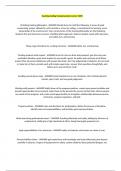Teaching Sailing Fundamentals Correct 100%
US Sailing training philosophy - ANSWER Should strive to instill the following: A sense of good
seamanship, proper attitude for self and others, a love for sailing, a commitment for learning, and a
stewardship of the environment. Four cornerstones of the training philosophy are the following:
Students first and instructors second, a building block approach, balance student needs with outcomes,
and safety, fun, and learning.
Three major directives for a sailing instructor - ANSWER Safety, fun, and learning
Treating students with respect - ANSWER arrive for class on time and prepared, give the class your
undivided attention, greet each student as you would a guest, be polite and courteous at all times,
protect their personal confidences with proper discretion, don't be judgmental of students, do not mock
or make fun of them, provide each with ample supervision, answer their questions thoughtfully, and
follow up on any promises made.
Avoiding sexual abuse steps - ANSWER Avoid isolated one on one situations, don't initiate physical
contact, play it safe, and use good judgement.
Working with parents - ANSWER Notify them of the programs policies, create many parent activities and
provide opportunities to be involved, report back to the parents the success of their kids, inform parents
any needs of the program, and create social opportunities to strengthen relationships between parents,
instructors, program organizers, and kids.
Program policies - ANSWER rules and directions for participation, define the process of discipline,
identify roles and responsibilities, and facilitate good communication.
What does being professional mean? - ANSWER Teaching effectively and safely, abiding by all terms of
employment, abiding by a high standards of ethics, being thoroughly prepared, etc.
legal responsibilities of an instructor - ANSWER safety of students, also known as a duty of care,
Prevent liability claims: - ANSWER gain experience and knowledge and teach effectively, plan lessons
carefully in advance, inspect all equipment for safety, caution students about potential dangers, etc
, Risk management goals - ANSWER Prevent injury or harm, recognize dangerous situations, reduce
number of all accidents, be prepared for the contingency of an emergency, and monitor and adjust as
exposures change and develop
Process for risk management - ANSWER identify risks, evaluate for best treatment, resolved the
identified risks,
Risk identification - ANSWER site assessment: identifying areas or items that may lead to injury around
the facility, the docks, and the boats themselves
risk resolution - ANSWER 1. eliminate the risk
2. reduce the probability that it will lead to a serious injury (ex: wearing shoes)
3. assume the risk
4. transfer the risk to a third party (ex: buy a lunch from a vendor instead of making it, or obtain
insurance and have the company take the risk)
risk financing - ANSWER instructors have a right to know exactly what financial protection has been
arranged for them by the sponsoring organization
Risk management - ANSWER risk assessment, risk control, and risk financing
Teaching theory - ANSWER new chapter
learning - ANSWER people learn differently, including instructors, if students don't learn, teaching is
ineffective, instructor succeeds only if the student does
Types of learning - ANSWER Visual learners, auditory learners, and kinesthetic learners
Visual learners - ANSWER Pictures, videos, and diagrams,




